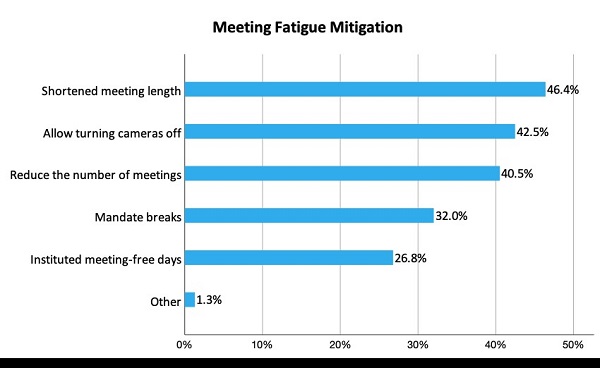According to Metrigy’s “Workplace Collaboration: 2021-22” global research study published in January:
- 82% of companies use video for all or most meetings
- 87% say that videoconferencing is important or critical to business operations
- 71% saw videoconferencing utilization continue to rise in the fourth quarter of 2020
- 57% are installing videoconferencing systems into all or most meeting locations
In addition, nearly half (49%) of companies participating in our fall 2020 "Customer Engagement Transformation" research study are using video for customer-facing use cases including support, training, and sales.
It is clear from these data points that videoconferencing has finally, after so many years of hype, become a core enterprise collaboration technology. Unfortunately, all of this video utilization, while improving interpersonal engagement by allowing for richer experiences that capture non-verbal communication, are creating burnout challenges. Video meetings require a different level of user participation than voice-only calls in which participants aren’t sitting or standing in front of a camera for long periods of time, always in view of others.
Among our workplace collaboration research participants, 34% say that video fatigue is now an issue within their organization. As research scientists increasingly study this phenomena, business, IT, and HR leaders are already implementing approaches to try and combat it.
Among our participants, common approaches include:
- Shortening meeting length down to 30 or 45 minutes from the standard one hour
- Allowing participants to turn cameras off during meetings if they feel that they need a break from video, or if they want to embark on physical activity during meetings such as a walk
- Reducing or setting a maximum number of daily meetings in an effort to avoid back-to-back-to-back-to-back… you get the idea… meetings throughout the day
- Mandating breaks between meetings, again to avoid the back-to-back issue
- Instituting meeting-free days to give employees a chance to take a break from video calls, focus on work, or if caught up, take some time away from work
Here at Metrigy we already had experience with the impact of hours upon hours of video calls over the last year and in January instituted meeting-free Fridays. It took a bit of an effort to not override the policy for that seemingly urgent meeting, but for the most part we’ve stuck with the approach and the feedback from our employees has been overwhelmingly positive. You feel a certain sense of accomplishment when you are able to use a full day to clear your task list and have some creative time rather than having four or five video calls with few available work blocks.
Another way to combat video fatigue is by improving the meeting experience. Here video meeting vendors like Cisco, Microsoft, RingCentral, and Zoom, have implemented or announced features such as the ability of speakers to put themselves in front of content, alternative participant views, and the ability to use gestures or emojis to share mood. Alternatively, creative meeting participants can use the open-source Open Broadcaster Software (OBS) to create their own virtual presentation experiences. Hardware vendors like Logitech and Poly have also gotten into the game, introducing personal devices featuring noise cancellation and AI to improve audio and video performance. However, meeting and hardware features alone can’t overcome the feeling of dread that many people experience when seeing a calendar full of video calls.
Business, IT, and HR leaders need to take a proactive approach toward combatting video burnout. The first step is gathering data from employees on how they feel about video meeting experiences. Here, analytics that show percentage of meeting participants with cameras enabled, and how that changes over time, can be a valuable tool, as can employee surveys and focus groups. Once data is in hand, consider some of the previously discussed approaches that limit video meetings or that encourage employees to turn off their cameras when they are feeling burnt out. Adopting such an approach can minimize burnout, improve video utilization overall, and lead to more productive, happier employees.
This article originally published on April 27, 2021 (click here for the original article).
Metrigy is an innovative research firm focusing on the rapidly changing areas of Unified Communications & Collaboration (UCC), digital workplace, digital transformation, and Customer Experience (CX)/contact center—along with several related technologies. Metrigy delivers strategic guidance and informative content, backed by primary research metrics and analysis, for technology providers and enterprise organizations.






